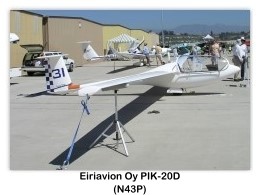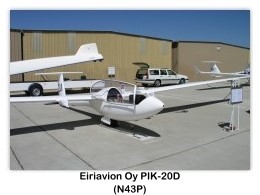
| ||||
|---|---|---|---|---|
 |
 |
 |
 |
 |



























| ||||
|---|---|---|---|---|
 |
 |
 |
 |
 |


























Eiri-Avion Oy PIK-20D
Single-seat high-wing sailplane, Finland
Archive Photos 1
Eiri-Avion Oy PIK-20D (N43P) on display (8/27/2005) at the Camarillo Airshow, Camarillo, California (Photos by John Shupek)



Overview 2
The PIK-20 is a Standard Class sailplane designed at the Helsinki University of Technology by Pekka Tammi, with advice from Ilkka Rantasalo and Raimo Nurminen. The prototype first flew in October 1973. It was produced initially by Molino Oy who were taken over by Eiri-Avion Oy (Currently Eirikuva Oy between 1974 and 1980. Later, production was taken over by the French company, Siren SA, under the name Siren PIK-20.
The first models were notable for using flaps instead of air-brakes for approach control. The specification of the Standard Class required full air-brakes capable of keeping the speed below the maximum speed in a vertical dive. However at high speed great force was needed to lower the flaps and so a geared crank handle was used. At the time the PIK-20 conformed with the rules for Standard Class because the flaps could only be used for landing.
The first prototype finished 13th in the World Gliding Championships in Waikerie in January 1974 but it performed impressively. (The low placing was caused by a poor decision on the first day of the competition.) The glider was then produced at the rate of two to three per week.
The rules of the Standard Class were changed again to allow the flaps and ailerons to move together (flaperons) and for intermediate settings of the flaps between landing mode and zero. The result was the PIK-20B which won British, American and Finnish National Championships in 1975. In 1976 Ingo Renner won the World Championship with a PIK-20B and second and third places were also taken by this type. Most owners of PIK-20A converted to the B’s flaperon arrangements. Carbon fiber spars later became standard.
Another change in the Standard Class rules prohibited flaps completely. As a result the PIK-20C was produced for the new 15 meter class.
PIK-20D added conventional Schempp-Hirth airbrakes, carbon reinforcement strips at critical locations in the fuselage, the nose profile was sharpened, the tail-plane was moved forward and fuselage fairings re-contoured to reduce drag. The flaps were limited to -12° to +20°. The first flight of the PIK-20D was in 1976.
The self-launching PIK-20E is similar to the PIK-20D model, but had a retractable Rotax 501 that took 15 turns of a manual crank in the cockpit to deploy or retract. The fuselage was slightly different, there was a slight sweep-back of the wings and the tailplane was larger. The Issoire Company in France produced a 17 meter PIK-30 version of the PIK-20E.
A PIK-20F had a modified wing profile, reshaped fuselage and a forward opening canopy.
The PIK-20’s were also notable for being conventionally painted rather than using gel-coat. This type of finish is longer lasting and simpler to repair.
The name PIK is an acronym for Polyteknikkojen Ilmailukerho, the flying club of the Student Union of Helsinki University of Technology.
A fire in the factory June 1977 dented production briefly but by then 200 gliders had been sold. Production continued until about 1980 with the PIK-20D and PIK-20E versions with over 400 PIK-20’s of all types made.
Specifications (PIK-20B) 2
General Characteristics
Performance
References